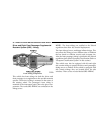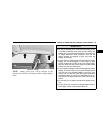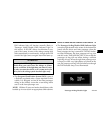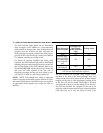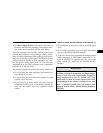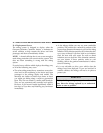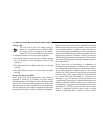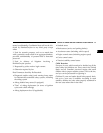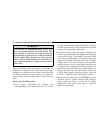
upper right side of the instrument panel separate and
fold out of the way as the bags inflate to their full size.
The bags fully inflate in about 50 - 70 milliseconds.
This is about half of the time it takes to blink your eyes.
The bags then quickly deflate while helping to restrain
the driver and front passenger. The driver’s front
airbag gas is vented through vent holes in the sides of
the airbag. The passenger’s front airbag gas is vented
through vent holes in the sides of the airbag. In this
way the airbags do not interfere with your control of
the vehicle.
•
The Occupant Classification Module (OCM) is lo-
cated beneath the front passenger seat. The OCM
classifies the occupant into categories based on the
measurements made by the seat weight sensors. The
OCM communicates with the Occupant Restraint Con-
troller (ORC). The ORC uses the occupant category to
determine whether the front passenger airbag should
be turned off. It also determines the rate of airbag
inflation during a collision.
•
Your vehicle has four Weight Sensors located between
the seat and the floor pan. The weight sensors measure
applied weight and transfers that information to the
OCM.
•
The Side Impact SRS Side Curtain Airbag are de-
signed to activate only in certain side collisions. When
the ORC (with side impact option) detects a collision
requiring the side curtain airbag to inflate, it signals
the inflators on the crash side of the vehicle. A quantity
of nontoxic gas is generated to inflate the side curtain
airbag. The inflating side curtain airbag pushes the
outside edge of the headliner out of the way and
covers the window. The airbag inflates in about 30
milliseconds (about one quarter of the time it takes to
blink your eyes) with enough force to injure you if you
are not belted and seated properly, or if items are
positioned in the area where the side curtain airbag
inflates. This especially applies to children. The side
curtain airbag is only about 3-1/2 inches (9 cm) thick
when it is inflated.
46 THINGS TO KNOW BEFORE STARTING YOUR VEHICLE



